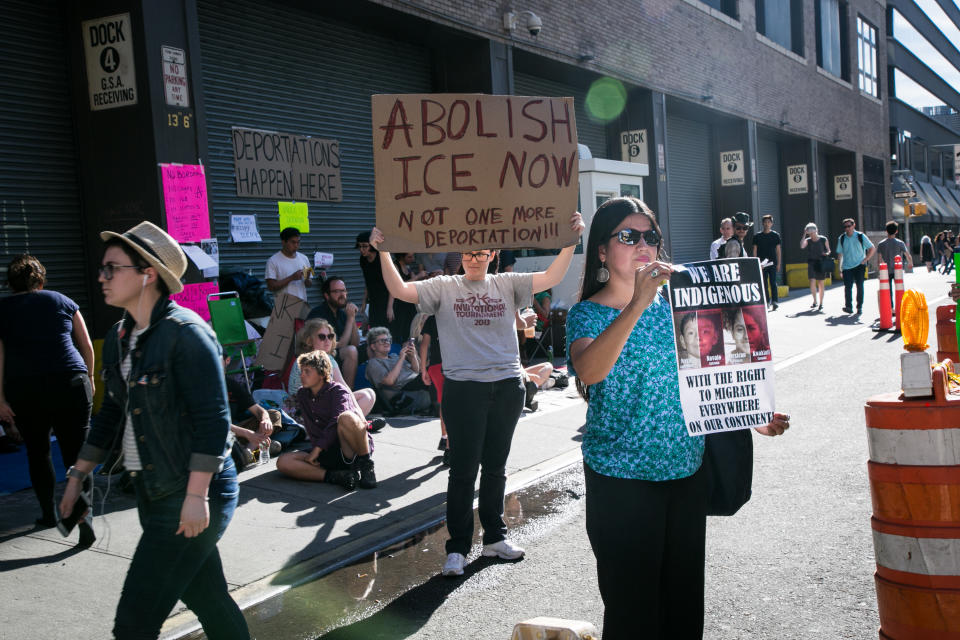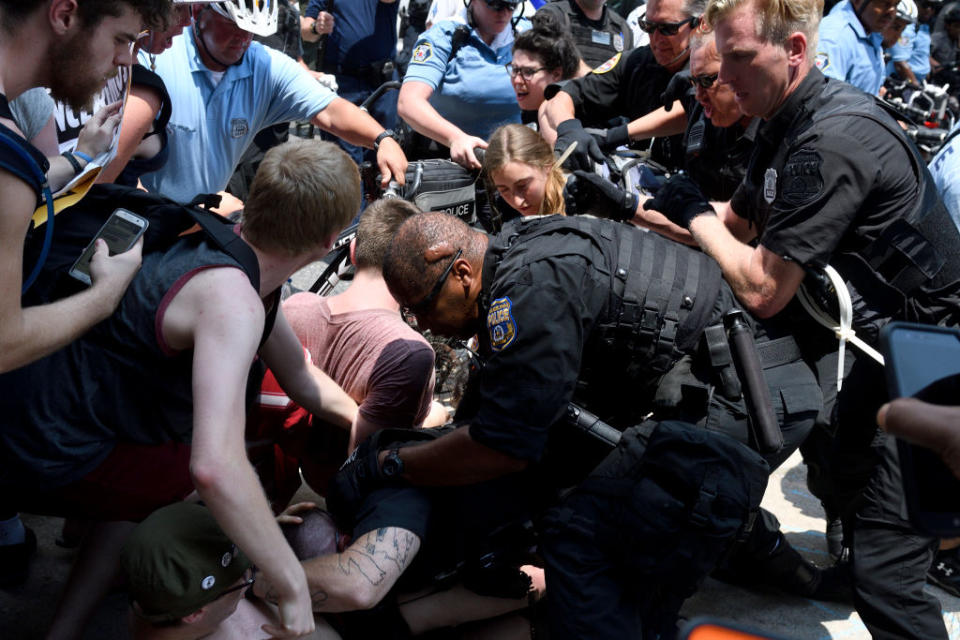Unfiltered: ‘If you’re an ICE agent … quit your job’
On the corner of West Houston and Varick Streets in New York City is a towering beige building. With rows upon rows of dark windows and a waving American flag at its entrance, it looks uniform and yet strangely foreboding. On most days, however, 201 Varick blends in with the rest of the cityscape.
But on June 25 a crowd stood outside its steps. Armed with homemade signs and posters, they yelled at a stream of cars driving past. “Deportations happen here! Deportations happen here!” they chanted.
The Varick Street building is home to the Immigration and Customs Enforcement (ICE) processing center, where immigrants are detained and appear before an immigration court. According to data from ICE, the total number of immigrant arrests in New York City has increased by more than 65 percent in just the last year.
On that June day, Marisa Holmes, a filmmaker and activist, was one of the protesters gathered outside the building. She watched as men in chains were loaded into vans, which drove out into the street from the exit of a post office next door after activists blocked ICE entrances. “It was very clear, you know, six guys lined up in handcuffs, being taken away,” said Holmes. “Not brought into the facility for court, but being taken out.” An NYU study found that ICE has routinely denied bail to detainees, having done so in approximately 80 percent of cases from 2005 to 2010. For those detainees, deportation is a very real possibility. Holmes’s group, the Metropolitan Anarchist Coordinating Council, or MACC, is one of the organizations leading Occupy ICE NYC, a group that’s part of a coalition protesting against ICE around the country.

Occupy ICE NYC was inspired by the actions of the first Occupy ICE, in Portland, Ore. When it started on June 17, the movement had no name — it began as a vigil being held outside the ICE detention facility to protest the Trump administration’s immigrant family separation policy. “We have detention facilities for children, and they’re reminiscent of Japanese internment camps,” a horrified Holmes said of immigrant children being forcefully taken from their parents. “Separation of families has always been a way to lay the groundwork for ethnic cleansing and genocidal policies.”
Eventually, the vigil transformed into a full-blown encampment. Individuals brought tents, set up a kitchen and provided legal services for immigrants going through the legalization process. Ultimately, protesters were shut down by the Department of Homeland Security (DHS) and ICE employees in full riot gear, but not before inspiring other places to create their own Occupy ICE groups — local Occupy outposts have popped up in cities like San Francisco, Tacoma, Los Angeles, Detroit and Philadelphia. They’ve attracted a slew of diverse participants; one city’s Occupy ICE Twitter account is run by a 16-year-old on summer break from school. “ICE is terrorizing certain parts of the population in this country,” explained Holmes. “It’s incredibly dehumanizing and criminalizing, and its very existence calls into question what kinds of values we have. … People are starting to realize that, and that’s motivating a lot of the occupations that are happening around the country.”
In New York City, dozens of individuals from activist organizations including MACC, Rise and Resist, and Shut It Down protested in front of 201 Varick for several days in a row. And, in what initially seemed like a victory, the ICE courts temporarily shut down. “Holy s***, it actually worked,” Gothamist reported one activist as saying. It soon became apparent, however, that the decision perhaps worked in ICE’s favor: Because the courts were closed for an indeterminate amount of time, bond hearings were postponed indefinitely — meaning detainees would stay longer in ICE custody. A spokesperson for the agency issued a statement that cited the protest’s calls for “violence against ICE” and DHS employees as the reason for the center’s temporary closure.
Occupy ICE NYC groups have called ICE’s move an attempt to scapegoat activists. “We were trying to stop people from being deported by putting our bodies on the line,” said Holmes, “and we were very clear from the beginning that we are not interfering with people coming into the building or disrupting the hearings for bonds.” In order for ICE to resume holding its bond hearings and allow pro bono legal representation for detainees, the protest was eventually called off. A statement made by Occupy ICE NYC about the decision read, “Human beings are not hostages to be used as bargaining chips.”
“DHS will use whatever opportunity possible to disrupt the kind of organization that we’re doing, especially if it gets attention and especially if groups that maybe don’t usually work together start working together,” says Holmes. “That’s really dangerous to DHS.”

Some occupation groups have become violent. A day before the July 4 holiday, crowds of Occupy ICE activists in Philadelphia and police officers clashed as the officers shoved, pepper-sprayed and arrested nearly 30 individuals. An embattled Holmes said enough is enough: “We need to abolish DHS … and find other ways of doing justice. We need to open the borders and not have these incredibly arbitrary lines dividing people. It’s really a fundamental transformation that has to happen to address what is driving ICE, and people who support ICE.”
Her message for ICE agents is clear: “Consider what orders you’re actually executing. And whether or not it is morally and ethically justifiable for you to do them.
“And quit your job.”


